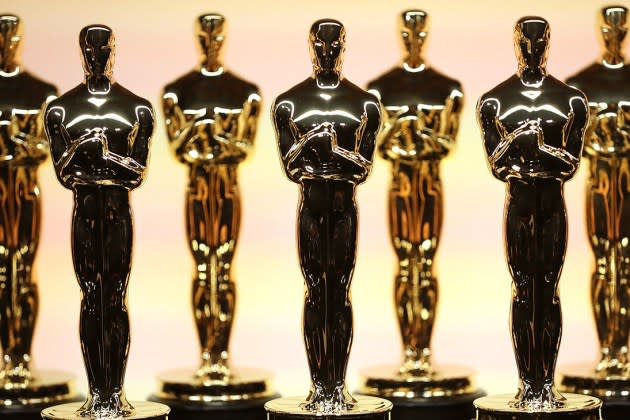Academy SciTech Awards Make a “Triumphant Return” As Lens Designer Iain Neil Accepts Oscar

After 40 years in Hollywood, veteran lens and optical systems designer Iain Neil received a standing ovation as he accepted the Gordon E. Sawyer Award, an Oscar statuette, Friday evening at The Academy of Motion Picture Arts and Sciences’ Scientific and Technical Awards presentation.
This capped a celebratory gathering of the close-knit entertainment technology community, where 20 innovators were honored during a ceremony in the Geffen Theater at the Academy Museum of Motion Pictures. At her first SciTech Awards ceremony and the first in-person SciTech presentation since 2019, Academy president Janet Yang opened the show, noting that the Museum was “a fitting venue for our triumphant return.” She told the SciTech community, “I’m in awe of the work you do.”
More from The Hollywood Reporter
Due to the stormy L.A. weather, the buffet dinner and after-party were moved from the Dolby Family Terrace to the 5th-floor tea room — and appropriately, the first honorees of the evening were recognized for making it rain. For the development of the Rain Bars system used to create practical rain on set, Technical Achievement awards (Academy certificates) were presented to Howard Jensen, Danny Cangemi and John Frazier. With the award, show host Simu Liu quipped that they set their system up at the Museum tonight.
Technical Achievement awards were presented to Mark Hills and Jim Vanns, for the FQ render farm management system at VFX studio Framestore, and Matt Chambers, for his contributions to render farm management system design at Sony Pictures Imageworks and Weta.
“The essence of a render farm is to handle the huge computational scale of VFX work,” said Hills (who has more recently co-founded audio tech company Cleanfeed). “Modern tech companies have their ‘data centers’ or ‘clouds.’ In VFX, we call these ‘render farms,’ but these days they do much more than just rendering and are used to drive the full breadth of VFX workflows.”
Technical Achievement awards were also handed out to Sébastien Deguy, Christophe Soum, Sylvain Paris and Nicolas Wirrmann for Adobe Substance 3D Designer software; and David Eberle, Theodore Kim, Fernando de Goes and Audrey Wong for the Fizt2 elastic simulation system developed at Pixar and used on its movies including Coco, Soul and Turning Red.
Kim thanked his unversity professor for encouraging him to pursue simulation, admitting that the professor suggested that rendering would be “boring.” Returning to the stage, host Lui quipped, “are things getting spicy at the SciTech Awards?” and asked if there might be a slap — the only reference of the evening to last year’s Oscars.
Scientific and Engineering awards (Academy plaques) were presented to Larry Barton and Ben Wilcox for Cinematography Electronics’ CineTape distance measurement system, which has been by focus pullers on movies from Dune to La La Land; and Howard Preston and Bernie Butler-Smith for the Preston Cinema Systems Light Ranger 2, which also provides focus distance information and has been used on films such as Ford v. Ferrari and The Trial of the Chicago 7. Preston offered sincere thanks to the focus puller community.
Oscar recipient Neil has developed lenses for Hollywood for films, like Titanic and Minority Report, and other industries (including tech used on a Mars rover). He has been the recipient of 12 Academy Awards for scientific and technical achievement. His career developing lenses for motion pictures included 18 years at Panavision, where he was an exec vp and CTO. He’s currently chief optics advisor at Cooke.
“Lenses have changed quite a bit recently because of digital imaging,” Neil reflected, noting that today, digital images can be described as more clinical. He noted that to make images look more filmic, options include vintage lenses or detuning lenses. “Or you design brand new lenses. That’s my favorite approach.” He emphasized that in lens development, “You need to talk to the artists. You have to understand what they want. You have to have a strong connection with the artists. Even with the migration from film to digital, the desired look has always been the same.
“Camera technology will change,” he said. “But all of that imaging relies on the lens.”
Ryan Laney accepted an award of commendation (special plaque) for his inventive use of AI-driven facial technology to give subjects a digital “disguise” to protect their identities while preserving their facial emotion in documentary filmmaking, as seen in 2020’s Welcome to Chechnya. Saying he was proud to contribute to “the ethical use of VFX in nonfiction storytelling,” Laney thanked director David France, Chechnya filmmakers and volunteers and spoke of their challenge to find “a truthful representation [of the subjects] and a more meaningful and impactful connection with the audience.”
During the ceremony, Barbara Ford Grant, chair of the Scientific and Technical Awards Committee, recognized the recipients of the 2021 Scitech Awards, which were presented virtually during the pandemic and were also on hand for this year’s celebration.

